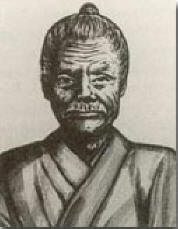
Kōsaku Matsumora was a respected practitioner of Tomari-te, a style of Okinawan martial arts that developed in the Tomari region. Kōsaku Matsumora was born in 1829 and received his training from various masters, including Karyu Uku and Kishin Teruya. He emphasized the development of technique, character, and discipline in his teachings and had notable students like Choki Motobu and Chotoku Kyan.
The Satsuma event
Kosaku Matsumora gained notoriety at the young age of 20 through a remarkable incident involving an angry Satsuma overlord and a seemingly unconventional weapon. According to the account provided by Shōshin Nagamine, Matsumora astounded onlookers when he disarmed the samurai by employing a “wet towel” as his chosen weapon.
Carrying a concealed moist Japanese towel, which had become a recent habit, Matsumora swiftly revealed his unique weapon. Striking the astonished samurai with the wet towel, Matsumora managed to seize the sword from his grip. However, in the midst of the encounter, Matsumora suffered the loss of his thumb. Undeterred, he discarded both the severed thumb and the sword into the nearby Asato River.
This extraordinary event deeply offended the Japanese overlords and catapulted Matsumora into the realm of Okinawan folk heroism virtually overnight. The story of his daring feat and sacrifice became a source of inspiration and admiration within the local community.
Kata
While there may be variations and different interpretations of the specific kata associated with Tomari-te, some of the commonly mentioned katas from this style include Passai, Rohai, Wanshu, and Naifanchi.
It is important to note that the specific kata associated with Tomari-te may vary among different lineages and interpretations. Additionally, the development and evolution of kata within martial arts styles can be subject to changes and adaptations over time.
While Kōsaku Matsumora is often mentioned as a respected practitioner of martial arts, particularly associated with the Tomari region, the historical details and specifics of his teachings and contributions are not as extensively documented as those of other prominent figures in Okinawan martial arts.
Given the limited historical information available, it is important to acknowledge that the details of Kōsaku Matsumora’s life, his exact role in the development of Tomari-te, and his specific contributions may be subject to varying accounts and interpretations. The available records may not provide a comprehensive understanding of his teachings or his impact on Tomari-te as a distinct martial arts style.
Thanks for reading.
Gert
